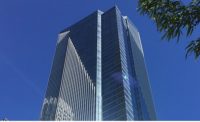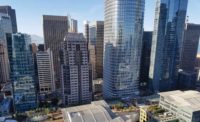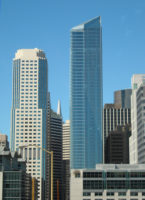This story originally ran in Engineering News-Record on August 10, 2016.
The 645-ft Millennium Tower—the tallest reinforced concrete structure in the Western United States—is sinking and tilting, and the building owner places the blame squarely on the adjacent Transbay Transit Center project.
The 60-story residential building in San Francisco’s fast-developing South of Market area has settled 16 in. and tilted 2 in. to the northwest since its completion in 2009.
Handel Architects, with structural engineer DeSimone & Partners, designed the $350-million building. Webcor Builders constructed it using a braced soil-cement slurry wall system with 80-ft-deep soldier piles located 5 ft on center, supporting a reinforced concrete slab. A 24-in.-thick reinforced concrete shear-wall core and a partial perimeter moment frame resist lateral loads.
P.J. Johnston, a spokesman for developer Millennium Partners, said in a statement that though “all buildings settle over time,” the tower “settled more than originally anticipated because it was affected by subsequent construction by others.” He added that the neighboring project was “obligated to monitor and protect existing structures, and to mitigate any impacts of their work.”
Transbay Joint Powers Authority, owner of the Transbay project, countered that Millennium Tower’s design was to blame and that the excessive settling started before construction began.
In a prepared statement, TJPA legislative-affairs and community-outreach manager Scott Boule says the design was paired with a concrete slab foundation that doesn’t reach bedrock 200 ft deep. He says the Millennium Tower “is made of concrete rather than steel, resulting in a very heavy building. This heavy structure rests on layers of soft, compressible soil. That foundation is inadequate to prevent settlement of a building with the weight of the Tower.”
He points out that the Salesforce and 181 Fremont towers—also adjacent to the Transit Center—are supported on piles drilled to bedrock. “Millennium Partners’ poor design decision is the cause of the tilt and excessive vertical settlement of the Millennium Tower,” Boule says.
Stephen DeSimone, president and CEO of DeSimone, counters that “buildings for decades have been founded on this Colma layer. To suggest that this is caused by anything other than the adjacent construction is a red herring.”
Tower geotechnical engineer Langan Treadwell Rollo declined to comment, as did Arup, TJPA’s engineering consultant. But Boule says seven years of data collected by Arup before excavation began on the Transit Center showed that instead of the maximum 6 in. of vertical settlement predicted by the designer over the lifetime of the project, by the time the TJPA started work in 2010, the Millennium Tower had already settled 10 in.
The building has continued to settle vertically to its current 16 in. According to data collected by Arup, the tower straightened slightly during the TJPA’s excavation for the underground levels of the Transit Center, but it never tilted past vertical toward the Transit Center and is currently tilting toward the west and northwest, away from the Transit Center.
TJPA spent $58 million to install 181 overlapping, 7-ft-dia reinforced concrete piles drilled to bedrock to act as an underground buttress between neighboring buildings (including the Millennium Tower) and the Transit Center. Boule says geotechnical monitoring data show that the buttress was entirely effective in preventing excessive movement of the tower due to the excavation for the Transit Center.
While the matter is likely to result in litigation, Johnston says that a safety study performed by Simpson Gumpertz & Heger showed that the building is not in danger.





